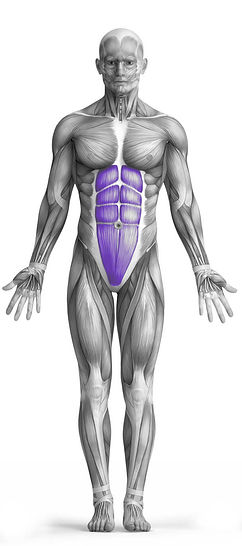Seated Scissor Kick 101 Video Tutorial
0

Exercise Synopsis
Target Muscle Group
Abs
Secondary Targets
Execution
Isolation
Force Type
Core
Required Equipment
Bodyweight
Fitness Level
Intermediate
Variations
None
Alternatives
Timer
Hour
Minute
Second
Stopwatch
00:00:00:00
Overview
The Seated Scissor Kick is a dynamic core exercise that specifically targets the abdominal muscles while also engaging secondary muscles such as the hip abductors and hip adductors. This bodyweight exercise requires no additional equipment, making it accessible and convenient for various fitness levels. To perform the Seated Scissor Kick, one sits upright on the floor with legs extended and hands supporting the hips, then alternates lifting and lowering each leg in a scissoring motion while maintaining core stability. This movement effectively strengthens the rectus abdominis and oblique muscles, promoting core stability and enhancing overall abdominal strength. Additionally, the engagement of the hip abductors and adductors provides supplementary benefits for hip stability and mobility, making the Seated Scissor Kick a comprehensive exercise for core and lower body strength.
How to Perform
To initiate the Seated Scissor Kick exercise, assume a supine position with your back firmly against the ground or on an exercise mat if preferred. Extend your arms fully to the sides, ensuring they remain stationary throughout the movement.
With a slight bend in the knees, elevate your legs so that your heels are approximately six inches above the ground, simultaneously contracting your abdominal muscles and lifting your back slightly off the floor. This establishes the starting position, emphasizing core engagement and stability.
Execute the movement by extending both legs outward in a scissoring motion, resembling the action of opening a pair of scissors. Return your legs to the center and cross them over each other, mimicking the motion of closing scissors.
Alternate between the scissoring movement of the legs while maintaining constant tension in the abdominal muscles. Ensure that your core remains activated throughout the exercise to maximize effectiveness and stability.
Complete the designated number of repetitions, focusing on controlled movements and maintaining proper form to effectively target the abdominal muscles and engage the secondary muscle groups, including the hip abductors and hip adductors. Regular practice of the Seated Scissor Kick contributes to improved core strength, stability, and overall abdominal development.
★ Bonus: For exercises that involve external weights (such as dumbbells, barbells, or machines), the One Rep Max (1RM) calculator can help you estimate your maximum lifting capacity. Use it to track your strength progress and adjust your training for optimal results.
Tips
Begin seated on the floor with legs extended, back straight, and hands supporting hips.
Engage core muscles by pulling belly button towards spine throughout the exercise.
Lift legs off the ground a few inches, maintaining a slight bend in the knees.
Open legs into a "V" shape while keeping core engaged and back straight.
Bring legs back together, crossing one over the other in a scissoring motion.
Alternate leg positions in a controlled manner, focusing on abdominal contraction.
Keep the movement slow and controlled to maximize muscle engagement.
Avoid overarching the lower back or allowing it to lift off the ground.
Ensure consistent breathing throughout the exercise to optimize oxygen flow.
Aim for a specific number of repetitions or time duration to challenge abdominal endurance and strength.
How Not to Perform
Avoid arching the lower back excessively during the exercise, as this can strain the spine and detract from the engagement of the abdominal muscles.
Refrain from lifting the legs too high off the ground, as this can lead to excessive strain on the hip flexors and may compromise proper form.
Do not rush through the movement; instead, maintain a controlled pace to maximize muscle activation and minimize the risk of injury.
Avoid holding your breath; remember to breathe steadily and rhythmically throughout the exercise to optimize oxygen intake and muscle function.
Do not rely solely on momentum to perform the scissoring motion; focus on using the abdominal muscles to control the movement and maintain stability.
Avoid swinging the legs forcefully, as this can strain the hip joints and detract from the effectiveness of the exercise.
Do not allow the arms to assist in lifting the legs; keep them relaxed and stationary to isolate the abdominal muscles.
Avoid overarching the neck or shoulders; keep them relaxed and maintain a neutral position to prevent tension and discomfort.
Do not neglect proper alignment; ensure that the head, neck, and spine remain in a straight line throughout the exercise.
Avoid pushing through pain or discomfort; listen to your body and modify the exercise as needed to avoid injury and ensure proper muscle engagement.
Variations
Variations of fitness exercises refer to different ways of performing a specific exercise or movement to target various muscle groups, intensities, or goals. These variations aim to challenge the body differently, prevent plateaus, and cater to individuals with varying fitness levels.
Alternatives
Alternative exercises in fitness refer to different movements or activities that target similar muscle groups or serve the same training purpose as the primary exercise. These alternative exercises can be used as substitutes when the original exercise is unavailable or challenging to perform due to various reasons such as equipment limitations, injuries, or personal preferences.








